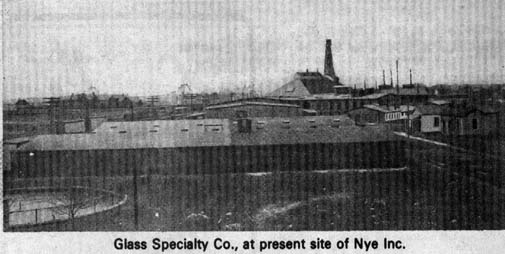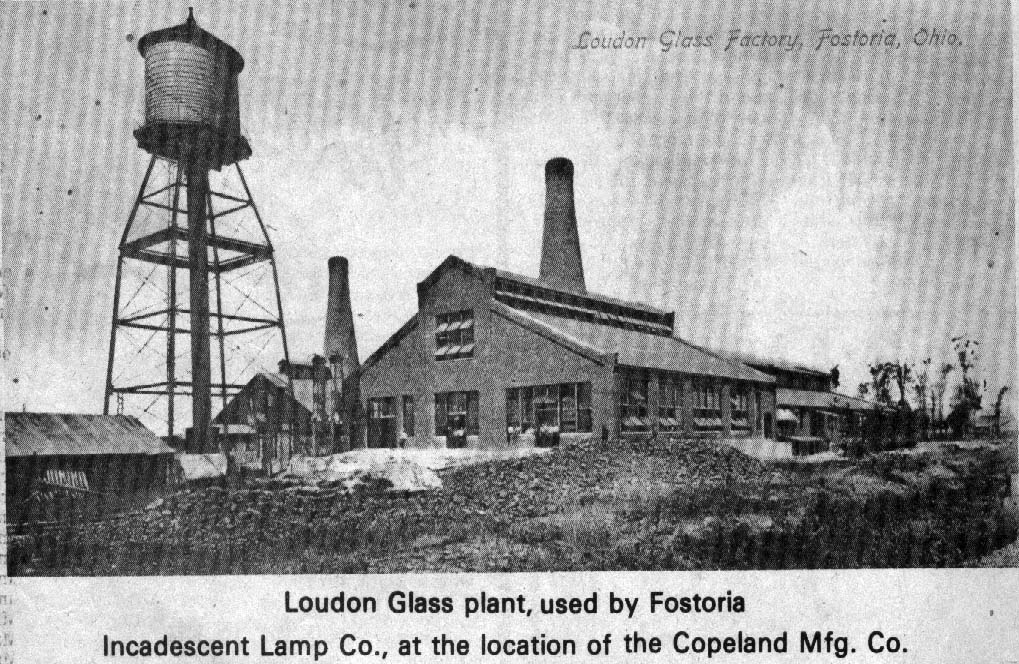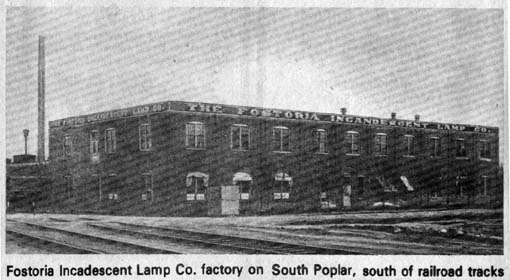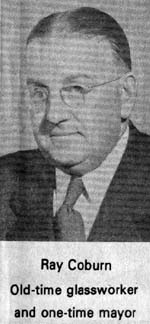August 31, 1978




Picture #1 – Glass Specialty Co., at present site of Nye Inc.
Picture #2 – Loudon Glass plant, used by Fostoria. Incandescent Lamp Co., at the location of the Copeland Mfg. Co.
Picture #3 – Fostoria Incandescent Lamp Co. factory on South Poplar, south of the railroad tracks
Picture #4 – Ray Coburn – Old Time glassworker and one-time mayor.
EDITOR’S NOTE: This is the third and last installment of the story about the Gas and Glass Days in Fostoria.
Some years ago when I was doing considerable traveling from the Fostoria Pressed Steel Corp. and whenever fellow travelers or business people learned I was from Fostoria, they invariably would say…”Oh, that’s where Fostoria glassware is made”. They still associated the two names, and thought the glassware was still made here. Not a bad association.
The many varieties of glassware manufactured in Fostoria Glass Factories during the past are treasured as collectors items by many people. Fostorians in particular.
Many of the types of glassware are illustrated in Mel Murray’s book “History of Fostoria, Ohio Glass 1887-1920”. Along with the many fine illustrations of glass items, there is also a much more extensive description of the events and personalities related to each one of the glass factories of that period.
This article cannot supplant the much more detailed work of Murray.
Ray Coburn, a glass worker for many years, can tell a lot of interesting tales about some of his associates back in the old days. Here’s several:
Lee Rigbee, a Fostoria and one of Ray’s friends, did a lot of freight- hopping, and finally lost a leg because of the practice. He carved a wooden leg for himself (not just a pegleg), and it worked fine.
Joe Eddy was another of Coburn’s friends, who in addition to being a glass worker was also a sort of an inventor and tinkerer. He invented a washing machine, long before they were on the market, which provided agitation to clean the clothes and which also incorporated a gas heater underneath to heat the water. He never sold his patent or produced another machine.
He also tells one related to the young age of some of the workers. One time, Coburn was an official for the glass workers union and visited a local in the east. He was taken to the union hall and there found that most of the officers were boys still in short pants.
The American Flint Glass Workers Union…the voice of the glass workers is celebrating its 100th Anniversary this year. Since Fostoria was deeply involved in the industry back there 100 years ago…it is appropriate to pay tribute to an industry and to the men who have made such a great contribution on the American industrial scene.
The AFGWU, in the July issue of American Flint, reviewed some of the history of its union and members, which now numbers 37,000.
Of particular interest, up-front in the magazine, was a photo of a monument erected at Corning, N.Y., in 1892, honoring 18 union members who resided in that area. On July 3, 1891, they were killed in a train accident at Ravenna, Ohio, when they were enroute from Findlay, Ohio, where they were all employed to visit friends and relatives in the Corning area.
Also of interest was a photo and item about Iva B. Harber, of Tiffin, local No. 574. to her went the honor in 1942 to be the first woman to become a member of the executive boar, representing the miscellaneous group at the U.S. Glass Co. plant, Tiffin.
PERSONALTIES
There are some names of men who were associated with the glass industry in one way or another that should be accorded space in this story. Here they are:
FRANK O’NEIL – A Fostorian who had a small machine shop here and was tinkering with ideas for the manufacture of machines for making certain glass items automatically and for bottle blowing.
O’Neil saw some dishonest dealings in Fostoria, according to Carmen (Ash) Lyons, and decided to move his business to Toledo.
According to Lyons’ historical records, after his move to Toledo in 1910, he perfected some of his ideas and manufactured machines that were used world wide. In later years he sold his company to Owens-Illinois Glass Co., but retained his Montreal, Canada plant which was reputed to be the largest in the world for producing glass-making machinery.
Mrs. Lyons refers to O’Neill as “Uncle Frank”, since her husband, Richard, was a nephew of Frank O’Neill. Mrs. O’Neill was the daughter of Alexander Brown, a pioneer family in Fostoria, he being the mayor of this city in 1886.
MICHAEL J. OWENS – like Frank O’Neill, he was an inventor as well as a glass- worker.
Although he worked at a glass plant in Findlay, he was well known to Hugh Coburn, father of Fostorian Ray Coburn.
He later moved to Toledo to work for the Libbey Co. and eventually produced a bottle-making machine, apparently about the same time O’Neill did. Who produced the first machine is unknown to the author.
Of course, the name OWENS later became identified very importantly with the Owens-Illinois interests in Toledo.
HENRY STURGESS – I remember Mr. Sturgess, even though I was only a small child when we lived beside the family on Taft Blvd.
The family come to town when General Electric started making Iris glassware, to compete with Tiffany. Mr. Sturgess had worked for a number of glass factories in this country as well as in England where he was born. He knew many well-guarded secrets of glass-making and made a great contribution to the production of Iris glassware in the GE plant.
His daughter, Mrs. Edith Babb, still resides in Fostoria.
HARRY EDMONDS – He was already a knowledgeable glassworker when he came to Fostoria to help establish the Fostoria Novelty Glass Co. When it failed, he became associated with the Anchor-Hocking glass factory in Lancaster, Ohio.
At another period in his glass career, Edmonds was sent to China by General Electric to teach the Chinese the art of glassmaking and to supervise a plant. That tour of duty lasted for about a year. When he returned to Fostoria to visit relatives and friends he brought me a Chinese silk handkerchief. Silk was made by silk worms then. I was about 10 or 12 at that time.
WALTER HICKS – Came to Fostoria in 1910 to work for General Electric. He previously worked in the Tiffany plant in New York. Later he worked for GE in Cleveland after the plants closed here. Still later, he joined Miller Glass Co. in Chicago as a salesman, a career he followed the rest of his working years. The town has changed so much since the early days that I can get lot here now. He says. Hicks is back in Fostoria now, at Good Shepherd Home, after more than 50 years absence.
RAY COBURN – A well-known citizen of Fostoria for many years, and respected by all those who know him, started in the glass industry at nine years of age. That first job of his at Macbeth Evans Co., Toledo, where his family lived then. The next year, when he was 10, his family moved to Fostoria, and he went to work at General Electric’s Upper Plant. Ray’s father and brothers were also glassworkers.
Like all young glassworkers he had to serve his apprenticeship until age 18 before being admitted to the union as a pate-mould blower. When he had attained that distinction, he went to a new GE plant at Niles, Ohio, and remained there five years. After that he worked in many other glass producing cities, winding up in Toronto, Canada, at which time he decided it was time to leave the industry.
During his years as a glassworker he served for six years on the executive board of The American Flint Glass Workers Union, of which he is still a member.
Ray is thoroughly conversant in all of the glassmaking processes and an interesting talker. Needless to say he has some beautiful and interesting glass specimens…many made in Fostoria.